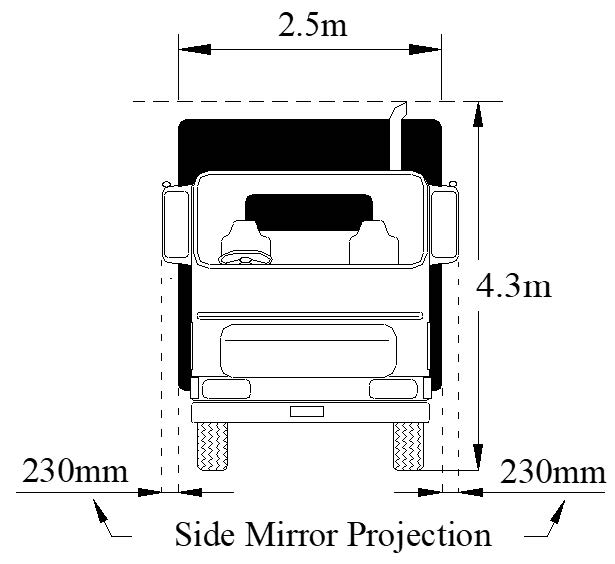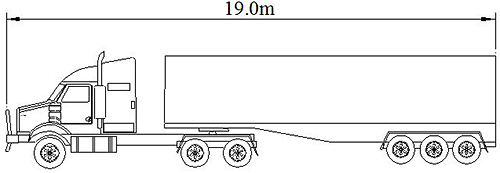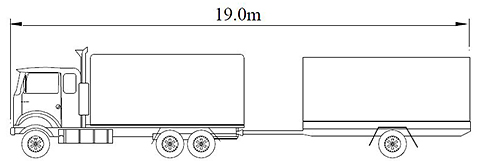Oversize or overmass vehicles
Dimension limits
New OSOM notices
From Thursday 3 April 2025, oversize and overmass (OSOM) notices will be introduced.
These notices will promote OSOM cross border access by allowing eligible vehicles to:
- travel at night
- have OS access during peak times
- no longer require a 3-year permit.
Eligible vehicles are those that meet dimension and vehicle type requirement, as per the notices.
For more information, call the permits officer on 08 8951 5263.
This page is about vehicle size limits in the Northern Territory.
It is the responsibility of the vehicle operator to check the relevant legislation.
Width
The overall width of a vehicle including any load must not be more than 2.5 m. This excludes any lights, mirrors, reflectors, central tyre inflation systems and signalling devices.
Vehicles with a gross vehicle mass (GVM) of over 3.5 t may have mirrors that project an extra 230 mm from the widest point of the vehicle, as long as they can fold in to 150 mm.
Height
Maximum vehicle height including any load is 4.3 m except for:
- vehicles designed to carry:
- livestock can be up to 4.6 m high
- motor vehicles on more than one deck may be up to 4.6 m high
- double-deck buses can be up to 4.4 m high.
Overhanging loads
You may carry loads that are longer or wider than the vehicle itself as long as they are within certain limits.
The rear overhang is measured from the centre of the rear axle or axle group to the extreme rear of the vehicle, including any load on the vehicle.
A load must not overhang in a way that is dangerous to people or property even if all dimension and warning requirements have been met - safety is still the main concern.
Any overhang must be contained within the maximum width limit of 2.5 m.
| (i) | Rear overhang is measured from the centre of the rear axle or axle group to the extreme rear of the vehicle including any load on the vehicle. |
| (ii) |
Rear overhang must not exceed the lesser of 60% of the wheelbase or 3.7 m. Rear overhang on loaded car carrier trailers, carrying vehicles on more than one deck, may be up to 4.9 m, and is measured from the rear overhang line to the rear of the rearmost vehicle carried on the trailer. |
| (iii) |
Projecting load to the rear - if a load projects more than 1.2 m from the rear of a vehicle, it must carry a warning signal attached to the rear of the load. In daylight, a warning signal is a brightly coloured flag with sides at least 300 mm long. At night, a warning signal is a red light that can be seen from a distance of at least 200 m. |
Length
The following images show the maximum length for various vehicles and vehicle combinations. All maximum lengths include any load the vehicle may carry.
Semi trailer
A trailer that has:
- one axle group or single axle to the rear
- an attachment to a prime mover that results in some of the load being imposed on the prime mover.
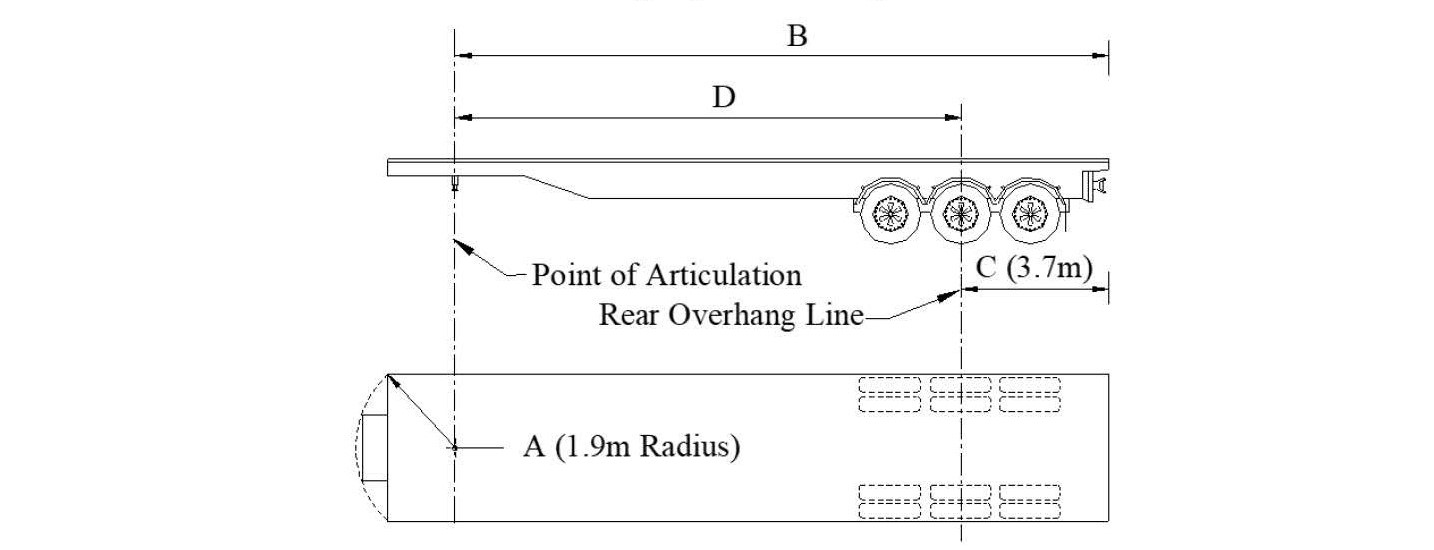
Use the following dimension schedules with the image above.
Standard semi trailer - single trailer combination
- Any projection forward of the point of articulation must not exceed 1.9 m.
- Distance from the point of articulation to the rear must not exceed 12.3 m.
- Rear overhang must not exceed 60% of (D) or 3.7 m - whichever is lesser.
- Distance from the point of articulation to the rear overhang line must not exceed 9.5 m.
14.6 m (48 ft) semi trailer - single or last trailer in road train or b-double combination
- Any projection forward of the point of articulation must not exceed 1.9 m.
- Distance from the point of articulation to the rear must not exceed 13.2 m.
- Rear overhang must not exceed 60% of (D) or 3.7 m - whichever is lesser.
- Distance from the point of articulation to the rear overhang line must not exceed 9.5 m.
Road train or b-double semi trailer
- Any projection forward of the point of articulation must not exceed 1.9 m.
- Distance from the point of articulation to the rear must not exceed 12.3 m.
- Rear overhang must not exceed 60% of (D) or 3.7 m - whichever is lesser.
- Distance from the point of articulation to the rear overhang line must not exceed 9.5 m.
Refrigerated semi trailer - positive control of temperature with refrigerated equipment - single trailer combination
- Any projection forward of the point of articulation must not exceed 1.9 m.
- Distance from the point of articulation to the rear must not exceed 13.6 m.
- Rear overhang must not exceed 60% of (D) or 3.7 m - whichever is lesser.
- Distance from the point of articulation to the rear overhang line must not exceed 9.9 m.
Livestock semi trailer
For a livestock trailer with 2 or more overlapping decks (eg. double deck), the available length for the carriage of livestock must not exceed 12.5 m measured within the body of the trailer.
Dog trailer
A trailer (including a trailer consisting of a semi tailer and converter dolly) that has:
- one axle group or single axle at the front that's steered by connection to the towing vehicle by a draw bar
- one axle group or single axle at the rear.
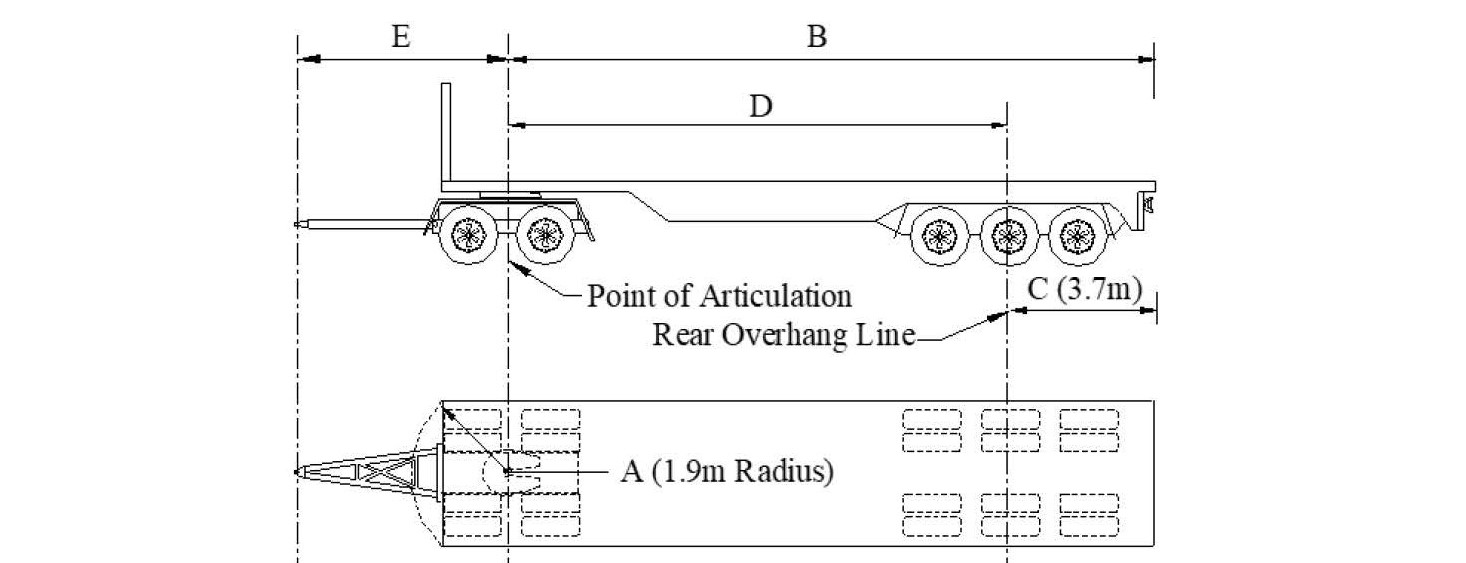
Use the following dimension schedules with the image above.
- Any projection forward of the point of articulation must not exceed 1.9 m
- Distance from the point of articulation to the rear must not exceed 12.3 m
- Rear overhang must not exceed 60% of (D) or 3.7 m, whichever is the lesser
- Distance from the point of articulation to the rear overhang line must not exceed 9.5 m
- Drawbar length is measured from the point of articulation on the tow coupling. Drawbar length not to exceed 5 m. If the trailer is used in a road train, drawbar length must not be less than 3 m.
Truck and dog trailer
A dog trailer has an axle group at the front of the trailer that can pivot and is connected to the towing vehicle by a drawbar. There is another axle group at the rear of the trailer.
Truck and pig trailer
A pig trailer has one axle group or a single axle near the middle of its load carrying area. It is connected to the towing vehicle by a rigid drawbar.
Pig trailer

B-double
A b-double is a vehicle combination made up of a prime mover towing 2 semi-trailers.
The length for a b-double truck is measured from the 'king pin' on the forward trailer to the end of the rear trailer as shown above.
Road train
A road train is a prime mover or rigid truck towing at least 2 trailers, that is not considered a b-double.


Car carrier
A car carrier is a truck that is specially designed to carry cars on overlapping decks. Car carriers are not the same as road trains.
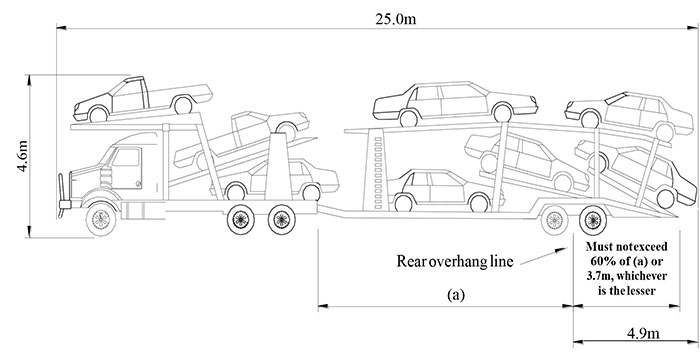
Ground clearance
A motor vehicle or combination must have a ground clearance of:
- at least 100 mm within one metre of an axle
- at least 1/30th of the distance between 2 axles when measured at the midpoint
- sufficient clearance to allow a vehicle to transverse the peak of a 1:15 gradient.
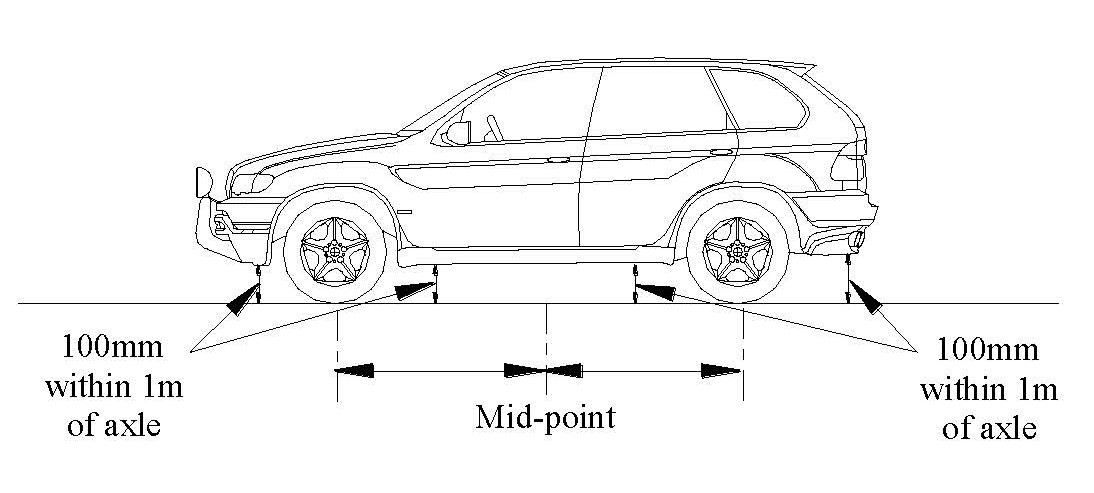

More information
For more information, read the:
- permit guidelines for oversize and overmass vehicles PDF (5.0 MB)
- V13 vehicle dimensional limits (including load) PDF (813.3 KB)
- national vehicle standards on the Australian Government's Department of Infrastructure, Transport, Regional Development, Communications and the Arts website.
You can also contact MVR by calling 08 8924 7157 or emailing vehiclestandards.mvr@nt.gov.au.
Print all pages in this section
Give feedback about this page.
Share this page:
URL copied!
